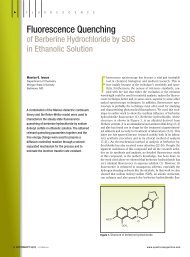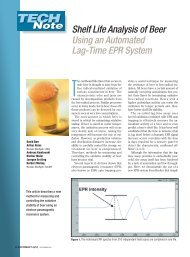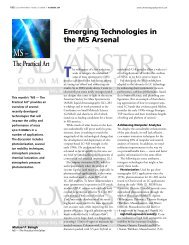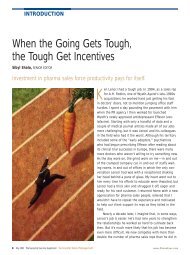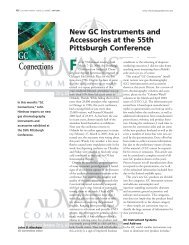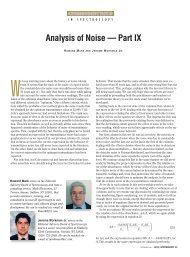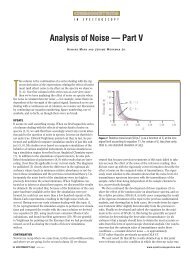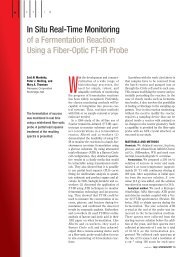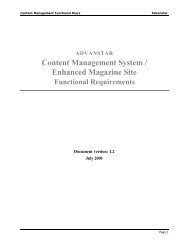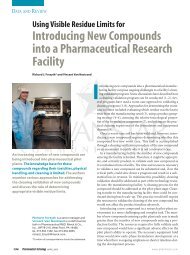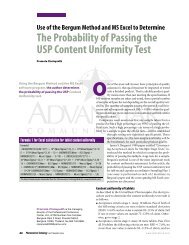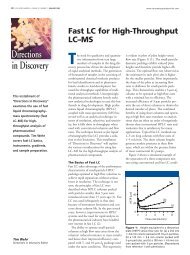How the Infrared Spectrometer Reached the Bench ... - Spectroscopy
How the Infrared Spectrometer Reached the Bench ... - Spectroscopy
How the Infrared Spectrometer Reached the Bench ... - Spectroscopy
You also want an ePaper? Increase the reach of your titles
YUMPU automatically turns print PDFs into web optimized ePapers that Google loves.
GUEST<br />
E D I T O R I A L<br />
<strong>How</strong> <strong>the</strong> <strong>Infrared</strong> <strong>Spectrometer</strong><br />
<strong>Reached</strong> <strong>the</strong> <strong>Bench</strong> Chemist<br />
P AUL<br />
A. WILKS<br />
The infrared spectrometer<br />
as we know it today got its<br />
start during <strong>the</strong> late<br />
1930s. Although Coblentz<br />
had discovered <strong>the</strong> infrared<br />
(IR) spectrum toward<br />
<strong>the</strong> end of <strong>the</strong> 19th century, 30<br />
years went by before <strong>the</strong> real<br />
value that existed in <strong>the</strong> IR<br />
spectrum began to be appreciated.<br />
Work began in earnest in<br />
several universities, notably at<br />
<strong>the</strong> University of Michigan<br />
(Ann Arbor), <strong>the</strong> University of<br />
Minnesota at Minneapolis–St.<br />
Paul, and at <strong>the</strong> Massachusetts<br />
Institute of Technology (Cambridge),<br />
usually in <strong>the</strong> department<br />
of physics.<br />
The IR laboratories were almost<br />
always tucked away in<br />
<strong>the</strong> basement of <strong>the</strong> physics<br />
building for several reasons.<br />
Dispersion of IR radiation into<br />
discrete wavelengths was usually<br />
accomplished with a rock salt prism<br />
that had to be kept in a dry atmosphere.<br />
Energy levels were measured with a <strong>the</strong>rmocouple<br />
having a signal that was fed to<br />
a galvanometer with a movement that<br />
was amplified by a lamp-and-scale device.<br />
This mechanism required a solid base<br />
that was free from vibration. Fur<strong>the</strong>rmore,<br />
<strong>the</strong> output of <strong>the</strong> <strong>the</strong>rmocouple<br />
would drift substantially with ambient<br />
temperature changes. The net result was<br />
that <strong>the</strong> early spectroscopists found basement<br />
locations best suited for <strong>the</strong> construction<br />
of <strong>the</strong> vibration-free, humidityand<br />
temperature-controlled rooms<br />
needed for successful operation of <strong>the</strong><br />
spectrometers.<br />
Also, needless to say, <strong>the</strong> spectroscopists<br />
were loath to admit outsiders<br />
that might upset <strong>the</strong> equilibrium of <strong>the</strong>ir<br />
habitat — especially during <strong>the</strong> scanning<br />
A whole new world for<br />
IR analysis opened up<br />
when Dow Chemical<br />
spectroscopists created<br />
<strong>the</strong> double-beam<br />
spectrophotometer.<br />
of a spectrum, which frequently took several<br />
hours. As a result, <strong>the</strong> early spectroscopists<br />
were looked on — rightly or<br />
wrongly — as recluses who spoke only to<br />
o<strong>the</strong>r spectroscopists. And IR spectroscopy<br />
became something<br />
of a black art that could be<br />
practiced successfully only<br />
by aficionados. IR spectroscopists<br />
continued to consider<br />
<strong>the</strong>mselves members of<br />
an elite group even after commercial<br />
IR spectrometers began<br />
to appear in <strong>the</strong> marketplace.<br />
The early IR instruments<br />
were single beam and were<br />
used primarily for quantitative<br />
analyses (1). The spectra<br />
that <strong>the</strong>y recorded followed<br />
<strong>the</strong> black body emission<br />
curve and had <strong>the</strong> atmospheric<br />
absorption bands superimposed<br />
on <strong>the</strong>m. Spectroscopists<br />
had to replot<br />
spectra ei<strong>the</strong>r manually or<br />
automatically to obtain useful<br />
quantitative data from <strong>the</strong>m.<br />
A whole new world for IR<br />
analysis opened up when<br />
Dow Chemical spectroscopists, under <strong>the</strong><br />
direction of Norman Wright, created <strong>the</strong><br />
double-beam spectrophotometer. Its<br />
spectra had a flat baseline and atmospheric<br />
bands were largely cancelled out.<br />
The result was an excellent spectrum<br />
with absorption bands uniformly presented<br />
from one end of <strong>the</strong> wavelength<br />
region to <strong>the</strong> o<strong>the</strong>r. These spectra could<br />
be used to directly identify materials as<br />
well as to provide structural information<br />
on unknown molecules and <strong>the</strong> new ones<br />
constantly being created by organic<br />
chemists.<br />
In 1951, PerkinElmer (Norwalk, CT)<br />
introduced <strong>the</strong> model 21 double-beam IR<br />
spectrometer — one of <strong>the</strong> most successful<br />
scientific instruments ever developed,<br />
and one that started PerkinElmer on its<br />
way to becoming a leading manufacturer<br />
of analytical instruments.<br />
14 SPECTROSCOPY 16(12) DECEMBER 2001 www.spectroscopyonline.com
....................................<br />
GUEST EDITORIAL .............................<br />
The founding fa<strong>the</strong>rs<br />
of IR spectroscopy, ra<strong>the</strong>r<br />
than being proved wrong<br />
that having IR fall<br />
into <strong>the</strong> hands of<br />
nonspectroscopists<br />
would prove to be a<br />
disaster, would be proud<br />
that <strong>the</strong> technology <strong>the</strong>y<br />
so carefully nurtured had<br />
become so widely useful<br />
in solving real-world<br />
analytical problems.<br />
In spite of its excellence in producing<br />
high-quality IR spectra, <strong>the</strong> model 21 did<br />
have some faults. One of <strong>the</strong> most serious<br />
was that if <strong>the</strong> operating controls were<br />
not properly set, <strong>the</strong> instrument could<br />
produce what came to be known as “spurious<br />
absorption bands” often caused by<br />
overshoot in <strong>the</strong> recording system. This<br />
occasionally led to wrong conclusions being<br />
drawn about <strong>the</strong> structure of a new<br />
molecule.<br />
Van Zandt Williams, <strong>the</strong>n Perkin-<br />
Elmer’s vice president of sales and research,<br />
became concerned that use of IR<br />
instruments such as <strong>the</strong> model 21 by inexperienced<br />
operators who mistakenly interpreted<br />
spectra, properly recorded or o<strong>the</strong>rwise,<br />
would eventually give IR<br />
spectroscopy a bad name and restrict its<br />
use. Fur<strong>the</strong>rmore, some of <strong>the</strong> spectra<br />
published by commercial organizations<br />
were recorded on materials of dubious purity,<br />
which could also lead to false<br />
conclusions.<br />
In an effort to rectify <strong>the</strong>se shortcomings,<br />
Williams, Wright, and a group of<br />
o<strong>the</strong>r dedicated spectroscopists banded<br />
toge<strong>the</strong>r to form <strong>the</strong> Coblentz Society,<br />
which describes itself as “a nonprofit<br />
organization in support of standards of<br />
excellence in vibrational spectroscopy.”<br />
Having recently celebrated its 47th anniversary,<br />
<strong>the</strong> Coblentz Society has indeed<br />
been IR spectroscopy’s watchdog. It<br />
has made available hundreds of topquality<br />
IR spectra from materials of<br />
proven purity; it has sponsored seminars<br />
and given awards for contributions to <strong>the</strong><br />
field; and it has acted as an ambassador<br />
of IR to o<strong>the</strong>r societies and organizations.<br />
<strong>How</strong>ever, like <strong>the</strong> early spectroscopists, it<br />
has remained somewhat aloof from <strong>the</strong><br />
real world of IR in quality control, process<br />
monitoring, forensics, and environmental<br />
monitoring. As a result, its members are<br />
largely from research centers and academia,<br />
and <strong>the</strong> society still looks on IR<br />
analysis as a science ra<strong>the</strong>r than a practical,<br />
widely applicable analytical tool.<br />
In <strong>the</strong> mid-1950s, as director of marketing<br />
at PerkinElmer, I was invited to <strong>the</strong><br />
Dupont Experimental Station. I was<br />
shown plans for a major expansion of <strong>the</strong><br />
station. Each section would have several<br />
analytical alcoves ra<strong>the</strong>r than a single analytical<br />
services center. As I recall, one of<br />
<strong>the</strong> Dupont people managing <strong>the</strong> expansion<br />
of <strong>the</strong> Experimental Station said,<br />
“The idea is to provide tools so that <strong>the</strong><br />
bench chemist could use <strong>the</strong>m to make<br />
his own analyses when he needed <strong>the</strong>m<br />
ra<strong>the</strong>r than wait his turn for results from<br />
a central facility. We believe IR is one of<br />
<strong>the</strong> most useful analytical methods a<br />
bench chemist can have to assist him in<br />
his work. <strong>How</strong>ever, currently available<br />
spectrometers like <strong>the</strong> model 21 are too<br />
complex and expensive. We need an instrument<br />
that <strong>the</strong> average chemist can<br />
use that is sufficiently low priced that we<br />
can place one in every analytical alcove.”<br />
When I brought back this message to<br />
my associates at PerkinElmer, it sparked<br />
an intense internal debate. Technically it<br />
was feasible to design a simple, fixedparameter<br />
instrument that could produce<br />
medium-resolution spectra and that could<br />
be marketed at a fraction of <strong>the</strong> cost of<br />
<strong>the</strong> model 21. <strong>How</strong>ever, <strong>the</strong> Coblentz approach<br />
argued that putting such an instrument<br />
in <strong>the</strong> hands of <strong>the</strong> bench<br />
chemist could only lead to disaster<br />
through misinterpretation of <strong>the</strong> spectra<br />
produced by it. More significantly,<br />
PerkinElmer management was totally opposed,<br />
fearing that <strong>the</strong> availability of a<br />
low-cost IR spectrometer would kill <strong>the</strong><br />
golden goose — <strong>the</strong> model 21.<br />
The debate ended abruptly when industrial<br />
espionage yielded <strong>the</strong> information<br />
that arch-rival Beckman was working<br />
on such an instrument.<br />
A crash program ensued and Perkin-<br />
Elmer’s model 137 <strong>Bench</strong> Chemists instrument<br />
was unveiled at <strong>the</strong> 1955 Pittsburgh<br />
Conference (as was <strong>the</strong> similar<br />
Beckman model IR5). The sales curve of<br />
<strong>the</strong> model 21 was watched carefully during<br />
<strong>the</strong> following months; it showed<br />
scarcely a blip in its steady growth curve.<br />
Meanwhile, acceptance of <strong>the</strong> model 137<br />
was immediate. Its first-year sales of 600<br />
units showed that it was reaching an entirely<br />
new unfilled market for IR analysis,<br />
<strong>the</strong> one envisioned by <strong>the</strong> Dupont<br />
planners.<br />
The model 137 and its descendants<br />
formed <strong>the</strong> basis for PerkinElmer’s IR<br />
program for <strong>the</strong> next 20 years, until <strong>the</strong><br />
advent of Fourier transform–infrared<br />
(FT-IR) spectrometers. Even <strong>the</strong> FT-IR<br />
program has followed <strong>the</strong> same pattern<br />
with <strong>the</strong> original, costly, research-only instruments<br />
being succeeded by eversimpler,<br />
lower-cost models aimed at<br />
bench chemists. Even special-purpose<br />
FT-IR spectrometers are beginning to appear,<br />
such as <strong>the</strong> Midac (Irvine, CA)<br />
open-air monitor and SensIR Technologies’<br />
(Danbury, CT) portable microscope<br />
FT-IR instrument. FT-IR is also moving<br />
into process monitoring — a far cry from<br />
<strong>the</strong> research laboratory.<br />
The founding fa<strong>the</strong>rs of IR spectroscopy,<br />
ra<strong>the</strong>r than being proved wrong<br />
that having IR fall into <strong>the</strong> hands of nonspectroscopists<br />
would prove to be a disaster,<br />
would be proud that <strong>the</strong> technology<br />
<strong>the</strong>y so carefully nurtured had become so<br />
widely useful in solving real-world analytical<br />
problems.<br />
REFERENCES<br />
(1) P. A. Wilks, <strong>Spectroscopy</strong> 16(3), 12 (2001).<br />
Paul A. Wilks is president of Wilks Enterprise<br />
(140 Water St., South Norwalk, CT<br />
06854) and a member of <strong>Spectroscopy</strong>’s<br />
editorial advisory board. He can be contacted<br />
by phone at (203) 855-9136 and by<br />
e-mail at pwilks@wilksir.com.◆<br />
DECEMBER 2001 16(12) SPECTROSCOPY 15



